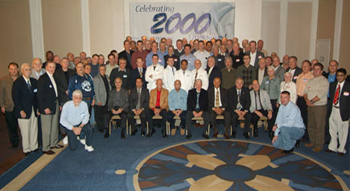Prostate cancer survivors gather to thank docs
Hundreds of prostate cancer survivors congregated at the Meadowlands Sheraton in East Rutherford on November 7 to thank the surgeons who made their survival a reality.

HUNDREDS OF PROSTATE CANCER SURVIVORS congregated at the Meadowlands Sheraton in East Rutherford on November 7 to thank the surgeons who made their survival a reality.
The surgery that saved them was robotic prostatectomy, a technique that has fast become the procedure of choice for prostate cancer patients. And the doctors they came out to celebrate were the four Monmouth Medical Center urologists who pioneered this procedure in New Jersey: Vincent J. Lanteri, M.D.; Michael P. Esposito, M.D.; Mutahar Ahmed, M.D.; and Gregory Lovallo, M.D., of the New Jersey Center for Prostate Cancer & Urology (NJCPC&U).
The event marked the doctors’ 2,000th successful procedure—the most of any practice in the state. In addition to meeting each other and sharing personal experiences, all those in attendance had the opportunity to “test-drive” the robot that helped to save their lives, the Da Vinci S Surgical System.
But these surgeons’ influence extends beyond those whom they’ve operated on personally: The doctors also teach one of the few courses on this robotic technique offered in the U.S. and have published the very first textbook on the subject.
Nearly 200,000 men are diagnosed with prostate cancer in the U.S. annually. In 2005, M.D. News magazine predicted that the robotic approach would be the future of prostate cancer surgery— and indeed, this has proven to be true, for many reasons, says Dr. Lanteri.
“In general, risks and complications are reduced, and recoveries are easier and shorter,” he says. “For instance, long-term incontinence and impotence are much less likely, there is less pain and risk of infection, the procedure is considered ‘bloodless’ due to minimal blood loss and the return to normal activity is much quicker.”
In 2006, Monmouth Medical Center, one of New Jersey’s largest academic medical centers, became the first hospital in Monmouth and Ocean counties to introduce the minimally invasive robotic surgery with the Da Vinci S Surgical System. This remarkable system uses computer and robotic technologies to enhance a surgeon’s skills. It creates a 3-D image of the surgical field and lets the surgeon get closer to the surgical site than human hands and vision permit. It also allows for more dexterity thanks to its EndoWrist instrumentation, which can move in more directions than a human wrist can, allowing for increased control in manipulating instruments and the ability to place sutures in more complex cases than is possible with traditional laparoscopy. As a result, the surgeon’s hand motion is seamlessly translated into movements more smooth and precise than any unaided human hand could achieve.
Now, three years later, Matawan resident Louis Dimino became NJCPC & U’s 2,000th success story when he underwent his robotic prostatectomy at Monmouth Medical Center.
Louis credits his wife, Patty, with taking the initiative to research all the treatment options thoroughly in the days following his cancer diagnosis, thereby allowing him to consider his best course of action. They heard strong recommendations for NJCPC & U from friends of theirs who were former patients, some of whom were speaking about their conditions for the first time. “Men don’t talk as easily
about these things as women do,” Patty says. “But get a bunch of them together and man, did they share! It helped us know what to expect and what we wanted to do.”
According to a recent study, robotic prostatectomy surgery patients have a 14 percent higher rate of cancer removal and, on average, regained urinary function
in about a month and a half—four times as fast as open- surgery patients. Robotic patients also experienced an increase in nerve sparing, which resulted in a lower incidence of sexual dysfunction compared with open- surgery patients, half of whom experienced impotence two years later.
When prostate cancer is detected in its earliest stage, the potential for survival dramatically increases—a process that begins with regular testing.
Men age 50 and older are encouraged to undergo an annual physician’s checkup that includes prostate cancer testing. Men at high risk for the dis- ease, including African-Americans and those with a family history of prostate cancer, should begin routine testing at age 40.
While one in six men will develop prostate cancer during their lifetimes, only one in 34 will die of the disease—underscoring the importance of early detection and treatment. In fact, when the malignancy is found while still confined to the prostate, the five- year survival rate is 100 percent, according to the American Cancer Society.
Prostate cancer is second to skin cancer as the most common type of cancer among American men— and the second most fatal, after lung cancer. In New Jersey, prostate cancer is diagnosed in about 6,000 men annually, claiming about 800 lives each year.

